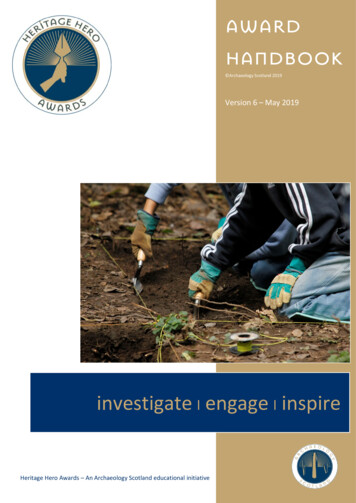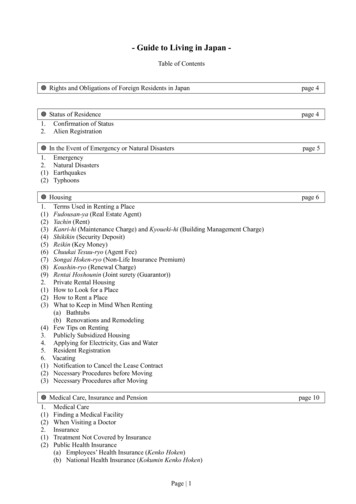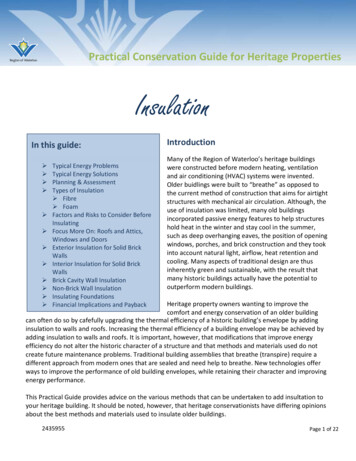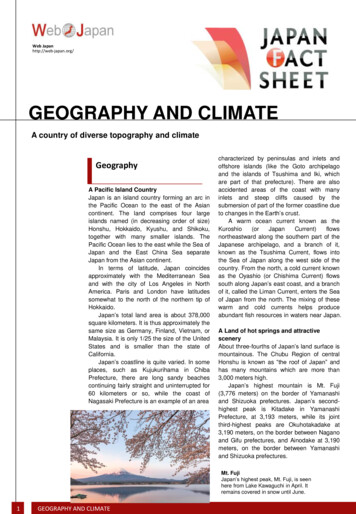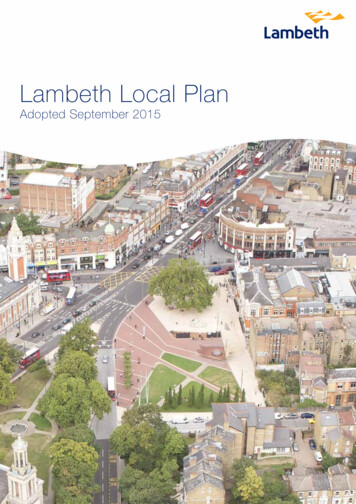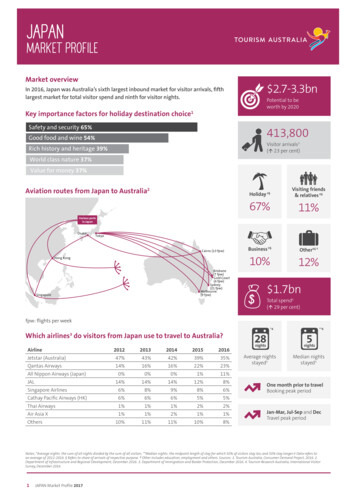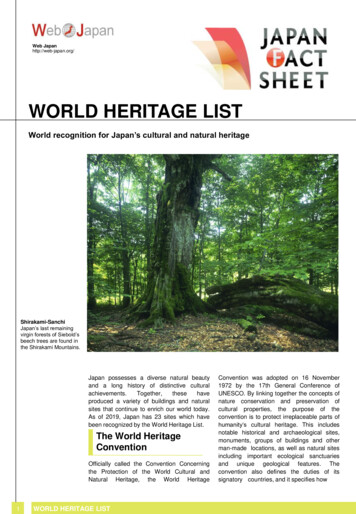
Transcription
Web Japanhttp://web-japan.org/WORLD HERITAGE LISTWorld recognition for Japan’s cultural and natural heritageShirakami-SanchiJapan’s last remainingvirgin forests of Siebold’sbeech trees are found inthe Shirakami Mountains.Japan possesses a diverse natural beautyand a long history of distinctive culturalachievements.Together,thesehaveproduced a variety of buildings and naturalsites that continue to enrich our world today.As of 2019, Japan has 23 sites which havebeen recognized by the World Heritage List.The World HeritageConventionOfficially called the Convention Concerningthe Protection of the World Cultural andNatural Heritage, the World Heritage1WORLD HERITAGE LISTConvention was adopted on 16 November1972 by the 17th General Conference ofUNESCO. By linking together the concepts ofnature conservation and preservation ofcultural properties, the purpose of theconvention is to protect irreplaceable parts ofhumanity‘s cultural heritage. This includesnotable historical and archaeological sites,monuments, groups of buildings and otherman-made locations, as well as natural sitesincluding important ecological sanctuariesand unique geological features. Theconvention also defines the duties of itssignatory countries, and it specifies how
Hiroshima Peace MemorialGround zero of the atomic bomb dropped onHiroshima on 6 August 1945 was160 meters southeast of the HiroshimaPrefectural Industrial Promotion Hall, thebuilding now known as the Genbaku Dome orAtomic Bomb Dome. (Photo courtesy ofAFLO)the World Heritage Fund is to be used tosupport tasks such as training assistance,technical cooperation,and emergencyassistance.As of 2019, 193 countries had ratified theconvention, and a total of 1,121 propertieshad been inscribed on the World Heritage List.The Closing Event of the 40th Anniversary ofthe World Heritage Convention was held inKyoto in November 2012.artists and poets. In the 12th century, Fujisanbecame the center of training for Shugendo,an ascetic religion including elements ofBuddhism and Shinto. It has been depicted inart since the 11th century, but its most widelyrecognized depictions are in the 19th centurywoodblock prints of Hokusai and other artists,in which it appears against crashing waves,pine groves, and surrounding lakes. Itssymmetrical form and unique outline continueto inspire artists around the world to this day.Cultural SitesBuddhist Monuments in the Horyu-ji Area(year of designation: 1993)Located in Nara Prefecture, the Horyu-jitemple was founded in the early 7th centuryby order of Prince Shotoku (574-622), whoplayed a key role in the introduction ofBuddhism into Japan. Although the templecompound was destroyed by fire in 670, itwas soon rebuilt on a larger scale within thecompound later designated as the WesternPrecinct. The extant pagoda, main hall(kondo), inner gate (chumon), and part of thesurrounding corridors are the oldest woodenbuildings in the world, dating from the late 7thto early 8th centuries. The Eastern Precinctwas added in the 8th century. The WorldHeritage designation covers 48 buildings.Fujisan, sacred place and source ofartistic inspiration (2013)At 3,776 meters, Mount Fuji, or Fujisan, isJapan's highest mountain, straddling theborder between Shizuoka and YamanashiPrefectures. The snow-capped peak ofFujisan is an iconic symbol of Japan that isrecognized throughout the world. It is anactive volcano, although it has not eruptedsince 1708, during the Edo era. The WorldHeritage designation consists of 25 sitesreflecting the essence of Fujisan's sacred andartistic landscape. Fujisan has long been theobject of pilgrimages, providing inspiration to2WORLD HERITAGE LISTMount Fuji snow-covered tip stands outagainst the springtime greenGusuku Sites and Related Properties ofthe Kingdom of Ryukyu (2000)The Kingdom of Ryukyu ruled the Ryukyuarchipelago, including Okinawa and manyother islands, for 400 years beginning in the15th century. The word gusuku means“castle” or “high place with an enclosure” inthe Ryukyu dialect. The nine propertiesinclude castle ruins and sacred sites that areimportant artifacts of the distinctive culturethat developed in these islands. Shuri Castle,located in the city of Naha, served as themain castle of the Ryukyu Kingdom. Sadly,four of the buildings of Shuri Castle, includingthe main Seiden hall, were destroyed by a firein October 2019. Reconstruction work isbeing planned with support from UNESCO.Hidden Christian Sites in the NagasakiRegion (2018)As a result of its frequent interaction withEuropean traders, the port of Nagasaki
became the center of a growing JapaneseChristiancommunity.TheTokugawaShogunate, however, adopted a policy ofnational seclusion and outlawed the newreligion. Despite the threat of harshpunishments if caught, many JapaneseChristians continued to practice their faith insecret, maintaining hidden places of worshipfor over 200 years. These communities of'Hidden Christians' went undetected untilJapan re-opened to the world in the 19thcentury. The World Heritage designationapplies to twelve locations in Nagasaki andKumamoto Prefectures. These includechurches built during the 19th and 20thcenturies on the former sites of secret placesof worship, and those which honor the historyof the Hidden Christians. It also includes theruins of Hara and Hinoe Castles, which weredestroyed as a result of the 1637-8Shimabara Rebellion of Christian resistance,and many sites on Hirado Island and inSakitsu Village.Himeji-jo (1993)Located in the city of Himeji, HyogoPrefecture, Himeji-jo is also known asShirasagi (White Egret) Castle because of itstall, white elegance. Although the castle wasfirst constructed during the mid-14th century,most of the 83 existing structures were builtbetween 1601 and 1609. The finest survivingexample of Japanese castle architecture,Himeji-jo was both a beautiful and formidablemilitary stronghold. Once past the outer walls,attackers would still have had to contend witha labyrinth of easily defended passagewaysbefore they could even approach the fourlinked donjons. The main compound is3WORLD HERITAGE LISTlocated on a hill 45 meters (148 ft) high, and,along with the adjoining west compound, it issurrounded by three rings of outercompounds. The main donjon appears fivestories high on the outside but is actuallyseven stories on the inside.Hiraizumi (2011)Located in the center of the Tohoku region,Hiraizumi is home to temples, gardens, andother historical remains of the Oshu Fujiwaraclan, which governed the Tohoku region forover 100 years beginning in the late 11thcentury. The designated site also includes asacred mountain. Built with al techniques, these temples andgardens represent the ideals of Pure LandBuddhism, a Buddhist school of thoughtwhich flourished in Japan during that era,expressing a peaceful world with no conflict.Especially well-known are Chuson-ji Temple,which houses golden Buddha statues, andMotsu-ji Temple, which has a pond thatrepresents the Pure Land. Together theyserve as a reminder of the glory of by-gonedays.Hiroshima Peace Memorial (GenbakuDome) (1996)Also known as the Genbaku Dome and theAtomic Bomb Dome, the Hiroshima PeaceMemorial has been preserved in the samecondition it was in following detonation of theatomic bomb dropped on Hiroshima on 6August 1945. The building was originally builtin 1915 as the Hiroshima PrefecturalIndustrial Promotion Hall. According to theWorld Heritage advisory body evaluation, it “isa stark and powerful symbol of theachievement of world peace for more thanhalf a century following the unleashing of themost destructive force ever created byhumankind.”Historic Monuments of Ancient Kyoto(Kyoto, Uji, and Otsu Cities) (1994)The ancient capital of Japan, Kyoto washome to the imperial court from 794 to 1868.As the center of Japanese culture for morethan 1,000 years, Kyoto is home to an
Shirakawa-goMany thatched gassho-zukuri farmhousescan be seen in the Shirakawa-go area.(Photo courtesy of Getty Images)incredible wealth of traditional architecture,including Buddhist temples, Shinto shrines,and imperial villas. Although a great manyothers could have been added, the WorldHeritagesitedesignationspecificallymentions 17 properties, including thefollowing. The temple Kiyomizudera is famousfor its wide veranda, which overlooks the cityfrom the east. The temples Kinkakuji (Templeof the Golden Pavilion) and Ginkakuji (Templeof the Silver Pavilion) served as villas forAshikaga shoguns in the 15th century. TheZen temple Ryoanji is home of Japan’s mostfamous Zen-style rock garden. Elegant NijoCastle served as the residence for theTokugawa shoguns during their visits to Kyoto.Located south of Kyoto in the city of Uji, thetemple Byodoin is home to one of the , the Hoodo (Phoenix Hall).Great Buddha of NaraThis 15-meter(excluding its pedestal)bronze statue of theBuddha Birushana hasbeen severely damagedandrestored several timessince its creation in AD752.4Historic Monuments of Ancient Nara(1998)From 710 to 784, Nara served as the capitalof Japan. Absorbing cultural and religiousinfluences, including literature, art andarchitecture, from Tang China, the citybecame a prosperous center of Japaneseculture. Nara was long the most importantcenter of Buddhism in Japan and this legacyis well represented in the World Heritageproperties. Most striking is the Great BuddhaHall of the temple Todaiji. One of the largestwooden structures in the world, it houses theGreat Buddha of Nara, a bronze statue 15meters tall (excluding its pedestal). Importantexamples of Buddhist architecture can alsobe found at the temples Kofukuji, Yakushiji,and Toshodaiji. The Kasuga-Taisha Shrine isnoted for its unique style of Shinto shrinearchitecture (kasuga-zukuri).Historic Villages of Shirakawa-go andGokayama (1995)The three mountain villages of Ogimachi,Ainokura, and Suganuma in the Shirakawago/Gokayama area contain many farmhousesbuilt in the gassho-zukuri style. The steepthatched roofs of these houses had to standup to the heavy snowfalls that isolated theremote villages in winter. The homes weredesigned so that the upper floors could beused for raising silkworms.WORLD HERITAGE LISTItsukushima Shinto Shrine (1996)According to tradition, Itsukushima Shrinewas established in 593. It is located on aHiroshima Bay island that has beenconsidered sacred since ancient times. Theshrine is famous for its large torii gate, whichstands 160 meters out into the bay, and for itsbeautiful vermillion shrine buildings whichseem to float above the water at high tide.Itsukushima ShrineDedicated to three tutelary deities ofmaritime transportation and built mostly overthe water of Hiroshima Bay, this shrine andits island setting are considered one of thethree most beautiful scenic sights in Japan.(Photo courtesy of Getty Images)Iwami Ginzan Silver Mine and its CulturalLandscape (2007)Located in the city of Oda in ShimanePrefecture, the Iwami Ginzan Silver Mine wasworked for approximately 400 years, from theearly 16th to 20th centuries. Following theintroduction of advanced mining techniques,in the 16th and 17th centuries the mineproducedhugequantitiesofsilver,contributing to the economic development ofboth Japan and Asia, where the silver wasused in international trade.Mozu-Furuichi Kofun Group: MoundedTombs of Ancient Japan (2019)Located on a plateau above the Osaka Plain,this World Heritage designation includes 49kofun burial mounds dating from between the3rd and 6th centuries CE. The mounds were
YoshinoyamaThe Yoshinoyama hills in the KiiMountains are famous for their cherryblossoms and historical sites.built in circular, square, keyhole and othershapes, and many of the larger ones aresurrounded by moats. Throughout Japan,over 160,000 burial mounds like these havebeen discovered, but these 49 are consideredto be the most culturally significant, housingthe tombs of ancient emperors and other elitemembers of society, and containing a widerange of funerary artifacts.Sacred Island of Okinoshima andAssociated Sites in the Munakata Region(2017)Located 60km off the northwest coast ofKyushu, Okinoshima is an exceptionalexample of the tradition of worshipping asacred island. The island contains a numberof archaeologically significant sites which arestill intact, providing a clear chronologicalrecord of how the rituals practiced there haveevolved since the 4th century A.D. The ritualsperformed at Okinoshima involved thedepositing of votive objects at different siteson the island, and these objects, many ofwhich were made by master craftsmen fromoverseas, provide us today with evidence ofthe trade that occurred between Japan, Koreaand the rest of Asia. Okinoshima is connectedwith the Munakata Grand Shrine in Kyushu,which houses many historic relics, includingseveral National Treasures of Japan.Sacred Sites and Pilgrimage Routes in theKii Mountain Range (2004)The sacred sites of Yoshino and Omine,Kumano Sanzan, and Koyasan are located inthe Kii Mountains, a densely forested regionsouth of the ancient capital cities of Nara andKyoto. Yoshino and Omine contain manymountain temples of Shugendo, a Buddhistmountain ascetic sect that incorporateselements of Shinto. Kumano Sanzan is thecollective name for three Shinto shrineslocated in the Kumano district. Koyasan is aBuddhist monastic complex located on amountain of the same name.Shrines and Temples of Nikko (1999)Nikko is most famous as the site of Toshogu,the Shinto shrine established in the 17thcentury to house the mausoleum ofTokugawa Ieyasu, founder of the Tokugawashogunate. Shrine buildings, such as themain gate known as the Yomeimon, arelavishly decorated with beautifully carved andbrightly painted figures. Also at Nikko are theFutarasan Shrine, the Buddhist temple Rinnoji,and a forest of huge cryptomeria treesplanted around the time Toshogu was built.Tomioka Silk Mill and Related Sites (2014)Tomioka Silk Mill was Japan's firstmechanized silk-reeling factory, established inthe southwestern part of Gunma Prefecture.Using Western technology, this governmentrun factory featured silk reeling machines with300 basins in a mill that was 140 meters long,making it one of the world's largest silk millsat that time. This innovation allowed the massproduction of raw silk, such that silk could beHetsu-miya, Munakata TaishaHetsu-miya is one of the three shrines that compriseMunakata Taisha. The Main Hall and Worship Hall havebeen designated as Important Cultural Properties bythe Japanese government.(Photo courtesy of Kyodo News)5WORLD HERITAGE LIST
Tomioka Silk Mill EastCocoon WarehouseThe main buildings ofTomioka Silk Millhave remained almostunchanged since theywere built about 150years ago.(Photo courtesy ofTomioka City)afforded by people all over the world,changing their lives and cultures for the better.SitesofJapan'sMeijiIndustrialRevolution: Iron and Steel, Shipbuilding,and Coal Mining (2015)Between the late 19th and early 20thcenturies, the foundations of the iron andsteel, shipbuilding, and coal mining industrieswere established, which later became keyindustries in Japan. Starting by observing thetechniques of Western industry andintroducing technology from overseas,Japan's industrialization was achieved in amere 50 years as a result of the efforts ofpeople nationwide. There are 23 sitesmarking Japan's Meiji industrial revolution,where industrialization from the West to anon-Westernnationwassuccessfullytransferred. These can be found in Kyushuand also in the Tohoku and Kanto areas.The Architectural Work of Le Corbusier, anOutstanding Contribution to the ModernMovement (2016)Architect Le Corbusier, who was born inSwitzerland and who became successful inFrance, was a major architectural influenceafter the beginning of the 20th century. TheNational Museum of Western Art in Ueno,Tokyo is the only building in Japan that hedesigned.Completedin1959,thisarchitectural work expresses his styles well,including pilotis, slopes, and illuminationplanning using natural light.The National Museum of Western ArtThe National Museum of Western Art, completedin March 1959, is the only building in Japan tohave been designed by Le Corbusier.(Photo courtesy of The National Museum ofWestern Art)Natural SitesNirayama Reverberatory FurnaceReverberatory furnaces were used to melt andrefine metals. The Nirayama ReverberatoryFurnace is one of three remaining reverberatoryfurnaces built at the end of the Edo period.(Photo courtesy of "Sites of Japan's MeijiIndustrial Revolution" World Heritage Council)6WORLD HERITAGE LISTOgasawara Islands (2011)This group of over 30 islands is located in thePacific Ocean approximately 1,000km southsoutheast of Tokyo. These islands areuninhabited apart from Chichijima andHahajima, and they host a rich variety of floraand fauna, as well as beautiful scenery. Asthe ecosystem has never been part of a largerlandmass, there are many life forms whichhave evolved in diverse ways and are uniqueto these islands; there are over 600 endemicspecies of animal and plant life, such as theBonin Flying Fox (Pteropus pselaphon).There are 57 species of endangered plantand animal species for which these islandsform an invaluable ecosystem.
Shirakami-Sanchi (1993)Located in the northern part of Japan’s mainisland of Honshu, the Shirakami Mountainsare covered with the last remaining virginforests of Siebold’s beech trees (see photo onpage1). Japanese black bears and Japaneseserow live in the forests along with many birdspecies.Shiretoko (2005)Shiretoko Peninsula is located in thenortheast corner of Japan’s northernmostisland of Hokkaido. Covered by denseconiferous forest and a massive volcanicrange, it is one of the wildest and mostremote regions in Japan. An excellentexample of the interaction of terrestrial andmarine ecosystems, Shiretoko is an importanthabitat for a number of endangered plant andanimal species.ShiretokoMany wild animals live in the unspoiled naturalenvironment of the Shiretoko Peninsula inHokkaido. (Photo courtesy of AFLO)Yakushima (1993)This World Heritage site designation coversover one-fifth of the island of Yakushima.Receiving the heaviest rainfall in Japan, theisland has subtropical coastal areas as wellas the tallest mountain in the Kyushu region.The forests contain many Japanesecryptomeria trees which are thousands ofyears old. One of those trees, known as theJomon-Sugi, is estimated to be more than7,000 years old.7WORLD HERITAGE LIST
secret, maintaining hidden places of worship for over 200 years. These communities of 'Hidden Christians' went undetected until . of the Golden Pavilion) and Ginkakuji (Temple of the Silver Pavilion) serve

